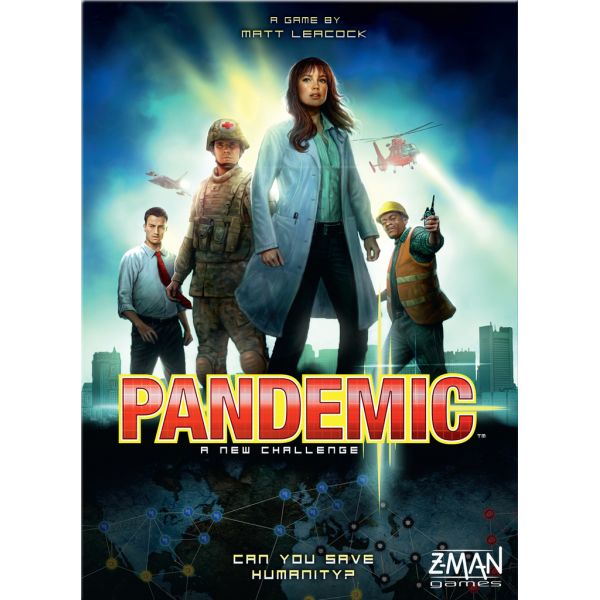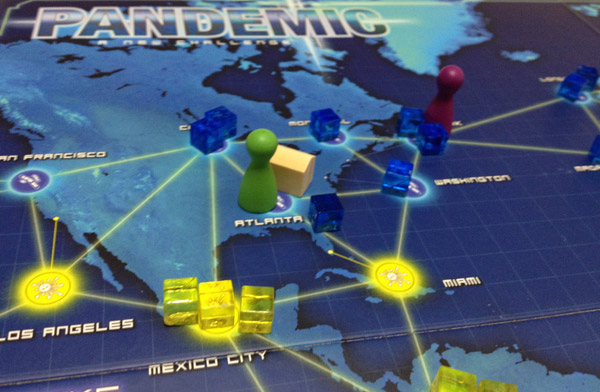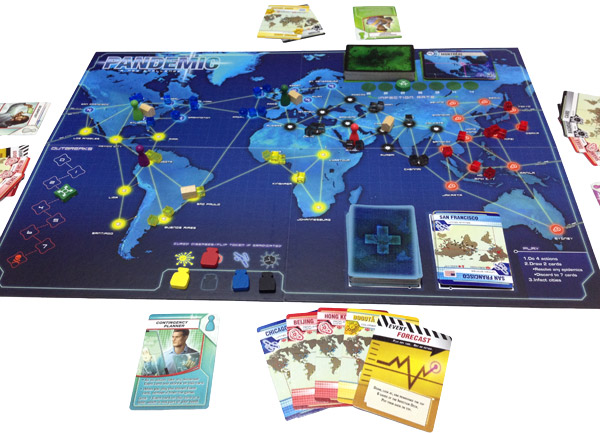Let's Cure Some Diseases! A Review of Pandemic

All of humanity is in danger! Four deadly diseases are wreaking havoc on mankind and you and your team of disease-fighting experts must cure them before they spread too much and become uncontrollable. Pandemic, by Z-Man games, is a very popular cooperative game that was first released in 2008, but a new edition in 2013 includes all-new artwork and components. But is this game an ideal choice for casual gamers?
Game Play
The Pandemic board is a world map that shows many major cities that may become infected during the course of the game. Infection cards determine which cities become infected. Disease cubes represent the diseases as they infect various cities and cause outbreaks to occur. A deck of player cards consists of cities of various colors, special events, and epidemics (which wreak extra havoc on the board). There are also research stations that are built on the map and various markers to keep track of cures, outbreaks, and the rate of infection.
At the beginning of the game, each player is given a role card (such as a medic or scientist) that grants him special abilities, as well as a pawn to represent his location on the map (all players begin in Atlanta, Georgia, where the Centers for Disease Control and Prevention (CDC) is located). Each player is also dealt a certain number of player cards, depending on the number of players in the game. 9 cities are infected initially, which occurs by drawing a card from the infection deck and placing disease cubes on that city.
There are 4 different diseases spreading throughout the world, represented by colors (black, blue, yellow, and red). The object of the game is to work together to cure all four diseases. On each turn, a player can decide to use 4 of 8 possible actions (one action may be used multiple times). These actions include movement actions, such as moving to an adjacent city, discarding a city card to fly to that city, moving from one research station to another, or moving to any city on the board by discarding the city in which the player is currently located. Other actions include building a research station, removing a disease cube from the player's current location, sharing a card with another player in the same location, or discarding 5 city cards of the same color to discover a cure for the disease of that color (a player must be at a research station to use this action).
After performing 4 actions, the player draws 2 additional cards and then infects cities. The number of cities infected starts with 2 and progresses up to 4 through the course of the game. When a city is infected, a disease cube of the color shown on the card is placed on that city. Even a disease that has been cured can cause new infections, unless it has been eradicated by removing all cubes of that color from the board. If there are already 3 cubes on the city and it gets infected again, an outbreak occurs, which requires a cube to be placed on all adjacent cities. If an adjacent city already has 3 cubes, an outbreak also occurs in that city — this chain reaction continues for any adjacent cities that already have 3 cubes. Outbreaks can definitely cause harm, and serve as a painful punishment if you're not diligently treating cities by removing cubes. Each time an outbreak occurs, a marker is advanced on the outbreak track.
Just when you're confident that you have the diseases under control, you'll have to deal with epidemic cards, which are shuffled evenly into the player deck before the game starts. Epidemics occur from 4 to 6 times (depending on the difficulty chosen by the players), and cause 3 things to occur that will put a wrench in your plans. First, they move the infection marker forward, which may increase the number of infections that will occur on each turn. Second, they infect a new city with 3 disease cubes — this card is drawn from the bottom of the deck. Third, they require all of the discarded infection cards to be shuffled together and placed on top of the infection deck — meaning that the cities players have already been trying to treat will start getting even more infections, which could easily lead to more outbreaks. Ouch! Fortunately, the event cards included in the deck can be used at any time to give players some added help when they need it most.
The game continues with infections occurring at an ever-increasing rate and players working together to keep the diseases at bay. If they manage to cure all 4 diseases, they win. However, if 8 outbreaks occur, the disease cubes are all used up, or the player card deck is depleted, the game ends immediately and the players lose.

Review
Pandemic is a great example of a cooperative game, and one that in many ways has become the standard for other games to follow. It has an interesting theme that many players can easily get emotionally involved in (I don't know of anyone who wants to see all of humanity destroyed by deadly diseases, although I'm sure there are crazies out there do). I believe the new artwork is a great update to the original, and the component quality is top-notch.
But back to my initial question: is this game ideal for casual gamers? I believe it falls solidly into what many call the "gateway game" category, meaning that it's more of an introduction to the world of hobby gaming than perhaps a casual game that can be picked up by anyone. The rulebook requires some studying and there is quite a bit to learn with regard to the many actions available on a turn and the different types of cards players will encounter. While most casual games offer a clear path to victory with a few options available to players, Pandemic is more "open-ended" in that it provides a plethora of options that players will have to figure out how to use to their advantage. That being said, it's not out of reach of the casual player who is willing to dive into the rules or who has a friend to offer some guidance. The rules offer many diagrams and examples, which are quite helpful. The publisher also provides a video tutorial to teach the basics of the game, which helped clear up a few questions for me.
One advantage of being a cooperative game is that if a player is confused, other players can jump in to provide suggestions and help out as needed. The rules allow the players to decide whether the cards in hand will be placed on the table face up or hidden from other players. I believe the face-up option is a better choice, seeing as though it reduces down time by allowing other players to get involved when it is not their turn. As with many cooperative games, however, there is a tendency for one player to get too involved and boss other players around. If this occurs, perhaps the hidden card option is a better choice to allow each player more flexibility to make their own decisions.
After giving it a try, and as a casual gamer myself, I can say that I enjoyed playing Pandemic. Despite a relatively long amount of time to set up and explain the rules, it offered a fun and interesting challenge that the other players in our test group also got into. It is not a game I would try to play with just anyone, but with the right group who is open to a bit more depth than many casual games offer, I'd say it's a good choice.
Pros: Interesting theme, high quality, challenging cooperative play
Cons: May be a bit too complex for many casual gamers
Full disclosure: we received a complimentary review copy of this game.








